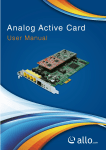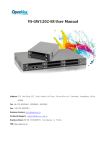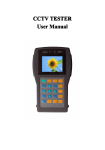Download User Manual ()
Transcript
Transcoding Card CT200E - User Manual No part of this publication may be copied, distributed, transmitted, transcribed, stored in a retrieval system, or translated into any human or computer language without the prior written permission of allo.com. Version: 1.0 Page 0 Transcoding Card CT200E - User Manual This document has been prepared for use by professional and properly trained personnel, and the customer assumes full responsibility when using it. Introduction to CT200E Series Documentation This manual contains product information for the CT200E Series cards. The manual is organized in the following manner: Chapter/Appendix Title Description Overview Identifies the features of your card. This chapter covers applications and uses of the CT200E Series in the real world. 2 3 Card Installation Configuration Provides instructions for installing the card in your PC, acquiring correct drivers, and checking device compatibility. Provides configuring options. 4 5 Specifications Reference Details card specifications. Helpful Reference web sites 6 Glossary and Acronyms Defines terms related to this product. 1 Version: 1.0 Page 1 Transcoding Card CT200E - User Manual Table of Contents Overview ........................................................................................................................ 3 Card Installation ............................................................................................................. 4 Unpacking the Card ................................................................................................... 4 Shipment Inspection................................................................................................... 4 Slot Compatibility ...................................................................................................... 4 Hardware Installation ..................................................................................................... 4 Software Installation ...................................................................................................... 4 Installation Test Environment considered .................................................................. 5 Asterisk compilation & Installation ........................................................................... 6 Allo Transcoding Card Installation ............................................................................ 6 Configuration ................................................................................................................. 7 Configuring the System for Transcoding ................................................................... 7 Status of card.............................................................................................................. 7 Testing ............................................................................................................................ 8 Limitations ..................................................................................................................... 8 Specifications ................................................................................................................. 9 Reference ....................................................................................................................... 9 Glossary and Acronyms ................................................................................................. 9 Version: 1.0 Page 2 Transcoding Card CT200E - User Manual Overview The CT200E Series cards are PCI-E base cards. The CT200E Series cards are designed to handle, transcoding in dedicated DSP hardware, it supports multiple voice codecs, to digitally compress voice signals and save on bandwidth. This function would otherwise be done by Asterisk in software. VoIP communication needs the capability to mediate between endpoints supporting different codecs, but this requires DSP functionality that are resource-intensive, and can affect the quality of the voice signals, and may introduces latency and delay. Asterisk, is capable of transcoding some codecs into other codecs for the purposes of call origination or termination, these transcoding in done by software and is very CPU intensive using substantial amount of CPU power. This CT200E card will add transcoding capability and provides excellent voice quality and transcoding capacity, without affecting latency or using up precious host CPU resources The CT200E card comes with bundled software to make the product architecture independent. For example the CT200E Series cards decompress G.729a (8.0 Kbit) or G.723.1 (5.3 Kbit and 6.3 Kbit) into u-law or a-law; or, compress u-law or a-law into G.729a (8.0 Kbit) or G.723.1 (5.3 Kbit and 6.3 Kbit). The CT200E Series cards are capable of handling up to 200 transcoding resources. All codecs are fully indemnified no additional licensing is required for their use. Allo.com Transcoding card CT200E is telephony PCIe card used for various PBX software, e.g. Asterisk, FreeSWITCH, etc. with compatible drivers, Features • Capable of doing the various codec transcoding. • Suitable for PCIe 1.0 slots • Provides up to 200 transcoding resources. • Supports G729, G723, a/u law, G726, ilbc (G722, AMR, AMR-WB, G722.1 HD etc will be implemented in future releases.) Version: 1.0 Page 3 Transcoding Card CT200E - User Manual Card Installation This chapter provides the following information: • • • • • Unpacking the Card Shipment Inspection Slot Compatibility Hardware Installation Software Installation Unpacking the Card When you unpack your card, carefully inspect it for any damage if present please contact and report to allo.com support. Shipment Inspection The following items are included in the shipment of the CT200E card: • CT200E PCIe card. • Installation CD Slot Compatibility Check the type of card you received to be sure it is compatible with your PCIe slot. The CT200E will work in any PCI Express 1.x compliant slot. Hardware Installation 1. Power down your computer and unplug it from its power source. 2. Remove the bracket place holder and insert the card into the PCI Express slot. 3. Replace the cover to your computer. Software Installation Allo.com Digital cards hardware are only supported under Linux. It requires drivers and libraries which are not integrated with the Linux kernel. Recommended Linux distributions: CentOS, Debian, Red Hat, and Ubuntu. Drivers and application software may be obtained from Allo.com’s download server at: http://www.allo.com/transcoding-card.html For an introduction to Asterisk, including additional information on its configuration, setups, and features, please refer to: http://www.asterisk.org Version: 1.0 Page 4 Transcoding Card CT200E - User Manual To install your CT200E card, you will need: Full Linux kernel 2.6.15 (or later) source code. Development libraries and headers for ncurses Development libraries and headers for zlib and openssl Development libraries and headers for newt GCC and standard software build tools Bridge tools (brctl) Installation Test Environment considered OS Kernel version Asterisk version Hardware Library : : : : : CentOS 5.5 (32 or 64 bit) 2.6.18-194.el5 Asterisk 1.4.43 ALLO Transcoding card allotc libraries 1. After inserting the card into your PCIe slot, boot your machine to Linux and execute the following command to list the devices detected by the PCI bus: # lspci Confirm the output lists a device with Allo.com’s PCI vendor ID which is “BCM57761”. The output will be similar to the following: 02:00.0 Ethernet controller: Broadcom Corporation NetXtreme BCM57761 Gigabit Ethernet PCIe (rev 10) Note: The output of lspci may or may not state “Allo.com”. If it does not, this does not indicate a problem. The Allo.com card identifier should be listed. If a card identifier is not listed, then your machine is not PCI 2.2 (or higher), and the card will not work. 2. To install asterisk in CentOS, we have to install the following prerequisite packages: • bison • bison-devel • zlib • zlib-devel • openssl • openssl-devel • gnutls-devel • flex • gcc • gcc-c++ Execute the following command to install the above mentioned packages: # yum install bison bison-devel zlib zlib-devel openssl openssl-devel gnutls-devel flex gcc gcc-c++ Version: 1.0 Page 5 Transcoding Card CT200E - User Manual Asterisk compilation & Installation For using Asterisk for your application, follow the steps below. Download Asterisk version 1.4.43. Expand the downloaded file, compile and install. #wget http://downloads.asterisk.org/pub/telephony/asterisk/re leases/asterisk-1.4.43.tar.gz # tar -zxvf asterisk-1.4.43.tar.gz # cd asterisk-1.4.43/ # ./configure # make # make install # make samples Allo Transcoding Card Installation 1. Download the driver from allo web site depend on the OS architecture, http://www.allo.com/firmware/transcoding/allo-transco-64bit-driver.tar 2. Copy the driver to /usr/src 3. Untar the file “tar xvf allo-transco-64bit-driver.tar” 4. Change the directory to allotc and run “./network install”, this will install Broadcom driver(tg3) and once the installation is over reboot the machine to make the eth1 interface UP Note: In some machines transcoding card eth interface may show as eth1 or eth2 depend upon the number of network cards present in the server. Allo Transcoding card can be identified with MAC id "00:17:F7:XX:XX:XX" 5. After reboot run “./install.sh <asterisk source path>” from the same directory Note: If the asterisk source directory is not provided for ex: “./install” the process will continue with Trix-Box/Elastix Installation. Operating Systems Other than Trix-Box/Elastix should mention the asterisk source as said. For E.g.: “./install.sh /usr/src/asterisk-1.x.x.” and for OpenSuse use “./open_suse_install <asterisk source path>” 6. The script will prompt you to enter the transcoding card based on the MAC address E.g.: CHOOSE THE ETERNET DRIVER IN WHICH YOU HAVE HWaddr 00:17:F7:00:00:00 Eg: If transcoding card interface is eth2 select "2" 7. The script will prompt you to configure ip address for transcoding card, configure IP address different from your network. E.g.: CHOOSE DIFFERENT IP OTHER THAN YOUR NETWORK FOR TRANSCODING CARD Eg: 10.1.1.1: 8. Script will prompt you to select the transcoding card depending upon the MAC id (00:17:F7:XX:XX:XX) E.g.: Please select device to configure: [1-1] q: quit 1 Version: 1.0 Page 6 Transcoding Card CT200E - User Manual 9. Setup the IP address for DSP in the transcoding module only the last octet E.g.: Specify last octet of the IP addres: [1-255] or <enter> for default: 10. Configure the port range with given interval E.g.: Specify udp base value [9000-65000] or <enter> for default: Configuration This chapter provides a step by step instruction to configure the CT200E transcoding card. Configuring the System for Transcoding 1. Finally change the RTP IP address in the file allo_codec.conf available in the prompted path (For Eg:/etc/asterisk) and change the “rtpip=<your machine ip>” 2. Configure SIP extensions by allowing all the codecs “allow=all” Status of card 1. Make sure the transcoding sessions are configured properly in the asterisk CLI prompt, Localhost CLI> allo show translators You should see the codec translators configured Version: 1.0 Page 7 Transcoding Card CT200E - User Manual Testing After installing the codec_allotc.so module, you can check the codecs which you have enabled in the configuration. As shown in following command. *CLI> core show translation Translation times between formats (in microseconds) for one second of data Source Format (Rows) Destination Format (Columns) g723 gsm ulaw alaw g726aal2 adpcm slin lpc10 g729 speex ilbc g726 g723 - 4001 2 1 - - 2001 - 1 gsm 3000 - 3000 2999 - - 1999 - ulaw 1 4001 - 1 - - 2001 alaw 1 4000 1 - - - 2000 g726aal2 - - - - - - adpcm - - - - - slin 1001 2000 1001 1000 lpc10 - - - g729 1 4001 speex - ilbc g722 slin16 - - - - - 3000 - - - - - - 1 - - - - - - 1 - - - - - - - - - - - - - - - - - - - - - - - - - - 1001 - - - - - - - - - - - - - - - - 1 1 - - 2001 - - - - - - - - - - - - - - - - - - - - - - - - - - - - - - - - - - g726 - - - - - - - - - - - - - - g722 - - - - - - - - - - - - - - slin16 - - - - - - - - - - - - - - Limitations Allo.com transcoding card comes with some of limitations, which are listed below; 1. G711 a/u law codec transcoding will be done for max 50ms of latency. 2. You might be expressing some delay if the other codec has 60ms or greater latency. Version: 1.0 Page 8 Transcoding Card CT200E - User Manual Specifications This chapter provides specifications, required environmental conditions for the CT200 Series cards. Physical card dimension Interfaces Environment Supported Codecs Size : 63.5 mm (height) × 94.3 mm (Length) PCI Express Bus - Compliant with PCI-E X1 1.0 or greater Temperature: 0 to 50° C (32 to 122° F) operation -20 to 65° C (4 to 149° F) storage Humidity: 10 to 90% non-condensing G.729a (8.0 Kbit) G.723.1 (5.3 Kbit and 6.3 Kbit) u-law a-law Reference http://www.allo.com http://www.linuxfoundation.org/collaborate/workgroups/networking/bridge http://www.asterisk.org http://www.voip-info.org Glossary and Acronyms a-law Mainly used in European telephone networks for the conversion between analog and digital signals in PCM applications. Similar to the North American mu-law standard. Bandwidth The capacity to carry traffic. Higher bandwidth indicates the ability to transfer more data in a given time period. Version: 1.0 Page 9 Transcoding Card CT200E - User Manual bps bits per second A measurement of transmission speed across a data connection. DTMF Dual Tone Multi-Frequency Push-button or touch tone dialing. G.711 A recommendation by the Telecommunication Standardization Sector (ITU-T) for an algorithm designed to transmit and receive mulaw PCM voice and Alaw at a digital bit rate of 64 Kbps. This algorithm is used for digital telephone sets on digital PBX. G.723.1 A recommendation by the Telecommunication Standardization Sector (ITU-T) for an algorithm designed to transmit and receive audio over telephone lines at 6.3 Kbps or 5.3 Kbps. G.729a A recommendation by the Telecommunication Standardization Sector (ITU-T) for an algorithm designed to transmit and receive audio over telephone lines at 8 Kbps. iLBC internet Low Bitrate Codec A free speech codec used for voice over IP. It is designed for narrow band speech with a payload bitrate of 13.33 kbps (frame length = 30ms) and kbps (frame length = 20 ms). Interface A point of contact between two systems, networks, or devices. Linux A robust, feature-packed open source operating system based on UNIX that remains freely available on the internet. It boasts dependability and offers a wide range of compatibility with hardware and software. Asterisk is supported exclusively on Linux. Multiplexing Transmitting multiple signals over a single line or channel. FDM (frequency division multiplexing) and TDM (time division multiplexing) are the two most common methods. FDM separates signals by dividing the data onto different carrier frequencies, and TDM separates signals by interleaving bits one after the other. MUX multiplexer A device which transmits multiple signals over a single communications line or channel. See multiplexing. Version: 1.0 Page 10 Transcoding Card CT200E - User Manual PBX private branch exchange A smaller version of a phone company’s large central switching office. Example: Asterisk. PCI peripheral component interconnect A standard bus used in most computers to connect peripheral devices. SIP Session Initiation Protocol An IETF standard for setting up sessions between one or more clients. It is currently the leading signaling protocol for Voice over IP, gradually replacing H.323. u-law Also known as mu law, is the PCM quasi-logarithmic curve. It is the 64 Kbps standard North America voice amplitude sample used for encoding/decoding. VoIP Voice over IP Technology used for transmitting voice traffic over a data network using the Internet Protocol. Version: 1.0 Page 11





















